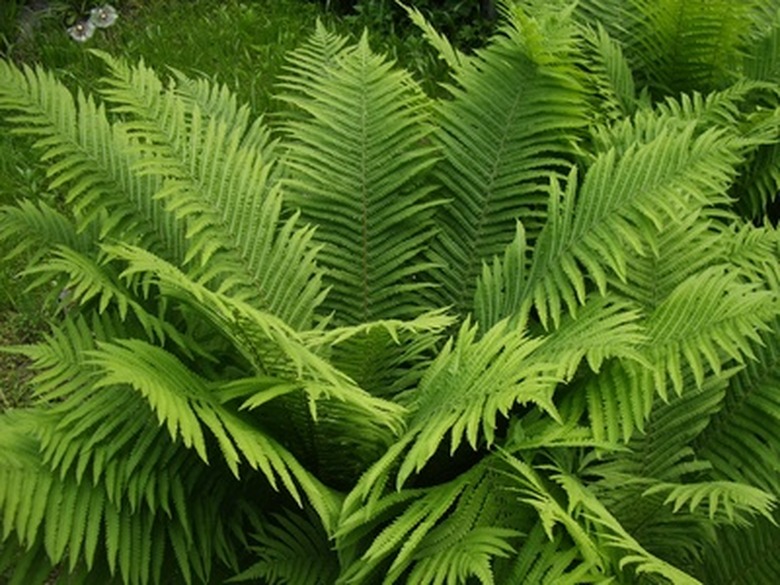Non-Poisonous Fern Plants For Children
Ferns are beautiful plants for house or garden, but if you have young children be aware that while some ferns are edible, others are poisonous. Ontario Ferns states that even "edible" ferns contain small levels of carcinogens and should only be consumed in small amounts. According to the University of Nebraska Cooperative Extension in Lancaster County, household plants are the third highest source of poisoning for children in homes. Select only non-poisonous fern plants for your home and yard.
Royal Fern
Royal fern (Osmunda regalis) is a non-toxic perennial fern that belongs to the Osmundaceae, or flowering fern, family. The U.S. Department of Agriculture lists this fern as palatable to humans. Royal fern is native to the eastern half of North America. Royal fern grows from spring through fall as a semi-erect, rhizomatous plant, up to 6 feet tall.
- Ferns are beautiful plants for house or garden, but if you have young children be aware that while some ferns are edible, others are poisonous.
- Royal fern (Osmunda regalis) is a non-toxic perennial fern that belongs to the Osmundaceae, or flowering fern, family.
Cinnamon Fern
Cinnamon fern (Osmunda cinnamomea) is a non-toxic fern whose fiddleheads–sprouting new fern plants–are considered edible, according to Ontario Ferns. Cinnamon ferns grow up to 5 feet tall near wetlands and swamps.
Ostrich Fern
Ostrich fern (Matteuccia struthiopteris) belongs to the Dryopteridaceae, or wood fern, family. Ontario Ferns states that this native fern is edible in moderation. It grows to 5 feet in height in the damp soil of forest areas.
Boston Fern
The University of Nebraska Cooperative Extension lists Boston fern as non-toxic. Also known as Boston swordfern, the Boston fern (Nephrolepis exalta) is another wood fern. It is a perennial fern native to Nebraska, Texas, Louisiana and Florida, as well as Hawaii, Puerto Rico and the Virgin Islands.
- Cinnamon fern (Osmunda cinnamomea) is a non-toxic fern whose fiddleheads–sprouting new fern plants–are considered edible, according to Ontario Ferns.
Hawaii Birdnest Fern
According to the University of Nebraska Cooperative Extension, the Hawaii birdnest fern (Asplenium nidus) is also non-toxic. According to the USDA Natural Resources Conservation Service, it belongs to the Aspleniaceae, or spleenwort, family and it is a perennial fern that is native to Hawaii.
Chamisso's Manfern
This is a fern that grows as a perennial tree. Chamisso's manfern (Cibotium chamissoi) belongs to the Dicksoniaceae, or tree fern, family and is native to Hawai'i. USDA lists this fern as nontoxic to humans. It grows between 10 and 23 feet tall.
Hapu'u
Native to Hawaii, hapu'u is another perennial fern tree in the Dicksoniaceae family. According to the USDA, it is nontoxic and grows year-round as an erect single stem that is 8 to 12 feet tall at maturity.
- According to the University of Nebraska Cooperative Extension, the Hawaii birdnest fern (Asplenium nidus) is also non-toxic.
- According to the USDA, it is nontoxic and grows year-round as an erect single stem that is 8 to 12 feet tall at maturity.
Growing Ferns
Ferns grow well in indirect sunlight exposure. It is a good idea to plant them under the shade of a tree in your yard or indoors near a north or east-facing window, according to the University of Vermont Extension Department of Plant and Soil Science.
Ferns thrive in moist, well-drained rich soil and are most comfortable in humid spaces, such as a bathroom or a warm room in the summertime. In the winter, use a humidifier to increase the room's humidity levels to recreate a comfortable environment for your ferns.
